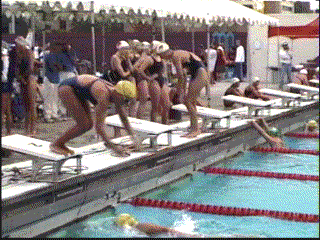

Swinging the Arms
In countless logos and and even on swimming trophies we see exemplified the erroneous starting position of swinging the arms back behind the swimmer as though this is the technique that represents competitive swimming. The following are just a few of the logos we have found on the Internet:
![]()
![]()
![]()
![]()
![]()
We have already discussed the disadvantages of the "leaning tree" syndrome on the typical relay starts page and the Buzz Lightyear Syndrome. (If you haven't read these yet. Click on the underline words to go to the page and then use your back button to come back here). Both of these syndromes take away from the immediate advantage of the elastic energy buildup and the quick snap of the jumping muscles.
The swinging of the arms behind the back is another "cosmetic movement" that does nothing to add to the real power of a start. Remember the real power comes from gravity. (see Galileo, Stage 3 of a Powerful Start and Roller Coaster Dynamics). Therefore it is important to get height. Swinging the arms may add momentum on the platform but any momentum that is gained on the starting platform is not significant compared to the momentum that is gained at the 15 meters or 12 yards from the start as a result of the power from gravity.
| Another PowerStartsTM Secret |
The power of the start comes from gravity. Any improvement in momentum from actions on the starting platform such as grabbing and pulling forward, or swinging the arms, or even taking a step-start, is insignificant compared to the power that comes from gravity. There are no real advantages to any movements that try to add to the momentum while on the starting platform compared to the power and momentum from gravity. So make your investment in actions that will add to gaining height, distance and a streamline entry angle.
Swinging the arms behind the back counteracts the elastic energy buildup that takes place during the squatting motion. The slow squatting motion as a result of swinging the arms back may actually hinder the effectiveness of a good vertical jump. As the elastic muscles are activated, force is increased in the tendon-muscle complex, increasing its stiffness or resistance to stretching. The result is a storage of elastic-energy in the muscles and tendons. The elastic-energy builds up and then is released with the "desirable movement."
The counter movement (squatting) and desirable explosive movement (jumping) typically require force to be developed in a time period between 200 and 350 ms (ms = milliseconds). It is not possible to swing the arms back behind the back and then forward in such a rapid movement while squatting at the same time.
